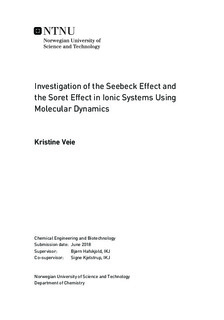| dc.description.abstract | Molecular dynamics simulations were performed in order to investigate the Soret and Seebeck effect in an electrolyte solution consisting of LiCl and water. A pure water system was also constructed in order to study the orientation of the water molecules when a thermal gradient is applied, and the electric field and the thermopolarization coefficient were calculated. In order to investigate if the contribution from the ions to the Seebeck effect in the electrolyte solution depends on the water molecules, a system consisting of LiCl was constructed, where the dielectric constant for water was used. The diffusion coefficients for water, lithium, and
chloride were calculated, in addition to the thermal conductivities for the systems.
The electric field and the thermopolarization coefficient in the pure water system are in good agreement with the results obtained by Armstrong and Bresme [1]. The electric field was calculated from two methods: by integrating the charge density and by summing the di- and quadrupole contributions to the field. According to Armstrong and Bresme, the methods should yield the same result [1]. In this thesis, the two methods were in agreement within the statistical error. From the sign of the dipolar contribution to the electric field, it was
concluded that the dipole moment of water points towards the hot side of the simulation box.
For the electrolyte solution, the two methods for calculating the electric field did not yield the same result. Within the statistical errors calculated in this thesis, the results are not equal to the results obtained by Lecce and Bresme [2]. When the field was calculated by integrating the charge density, the Seebeck coefficient was equal to (-8±3)·10-4 V K-1. The coefficient calculated by Lecce and Bresme is approximately equal to -3·10-4 V K-1 [2]. Since Lecce and Bresme did not give the standard deviation of the coefficient, it is difficult to say how different the results are, but the coefficients have the same sign and order of magnitude. In this thesis, both of the methods for calculating the electric field yielded a positive ion contribution and a negative water contribution, and this is in agreement with Lecce and Bresme s results. The pressure in this system and the system size were different from what Lecce and Bresme used, and this could have influenced the results. The results in this thesis indicate that the Seebeck effect is a sensitive effect. The Soret coefficient calculated for
the electrolyte solution is in good agreement with the coefficient calculated by Lecce and Bresme, given in [2].
In the system consisting of LiCl, where the dielectric constant for water was used, the calculated Seebeck coefficient differed from the one calculated for the electrolyte solution. This indicates that the ion contribution to the Seebeck coefficient in the electrolyte solution depends on the water molecules. | |

